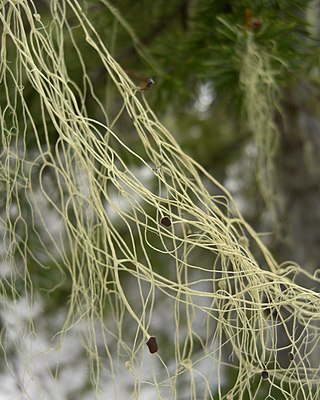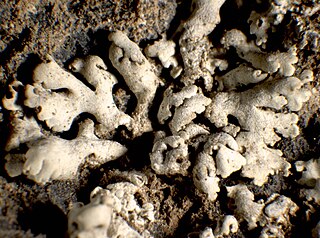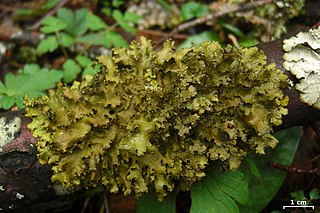
Letharia vulpina, commonly known as the wolf lichen, is a fruticose lichenized species of fungus in the family Parmeliaceae. It is bright yellow-green, shrubby and highly branched, and grows on the bark of living and dead conifers in parts of western and continental Europe and the Pacific Northwest and northern Rocky Mountains of North America. This species is somewhat toxic to mammals due to the yellow pigment vulpinic acid, and has been used historically as a poison for wolves and foxes. It has also been used traditionally by many native North American ethnic groups as a pigment source for dyes and paints.

Xanthoparmelia chlorochroa, known as the tumbleweed shield lichen or ground lichen, is a foliose lichen in the Parmeliaceae family. It is not fixed to a substrate, and blows around in the wind from location to location.

Hypogymnia is a genus of foliose lichens in the family Parmeliaceae. They are commonly known as tube lichens, bone lichens, or pillow lichens. Most species lack rhizines that are otherwise common in members of the Parmeliaceae, and have swollen lobes that are usually hollow. Other common characteristics are relatively small spores and the presence of physodic acid and related lichen products. The lichens usually grow on the bark and wood of coniferous trees.

Lichens are symbiotic organisms made up of multiple species: a fungus, one or more photobionts and sometimes a yeast. They are regularly grouped by their external appearance – a characteristic known as their growth form. This form, which is based on the appearance of vegetative part of the lichen, varies depending on the species and the environmental conditions it faces. Those who study lichens (lichenologists) have described a dozen of these forms: areolate, byssoid, calicioid, cladoniform, crustose, filamentous, foliose, fruticose, gelatinous, leprose, placoidioid and squamulose. Traditionally, crustose (flat), foliose (leafy) and fruticose (shrubby) are considered to be the three main forms. In addition to these more formalised, traditional growth types, there are a handful of informal types named for their resemblance to the lichens of specific genera. These include alectorioid, catapyrenioid, cetrarioid, hypogymnioid, parmelioid and usneoid.
Stephen Sharnoff is a photographer, especially of botanical and lichen subjects. He specializes in close-up botanical color work. He is also a research associate at the University and Jepson Herbaria of the University of California, Berkeley and a past associate of the Missouri Botanical Garden.

Alectoria sarmentosa is a long-lived, perennial witch's-hair lichen. It is a light greenish colored and fruticose or bushy bodied. This epiphytic lichen belongs to the family Parmeliaceae and the suborder Lecanorineae, which includes six similar species. A. sarmentosa grows draped or strung over conifer tree limbs and deciduous shrub branches in Northern temperate rainforest. This lichen favors mature and old growth, wet conifer and hardwood forests with clean air. A. sarmentosa is sensitive to air pollution and used for air quality monitoring. Areas required by A. sarmentosa are found in northern and southern temperate zones and receive high rainfall. This lichen is commonly found in transitional areas between valley and mountainous forests, but usually avoiding the immediate coast.

A podetium is the upright secondary thallus in Cladonia lichens. It is a hollow stalk extending from the primary thallus. Podetia can be pointed stalks, club like, cupped, or branched in shape and may or may not contain the ascocarp, the fruiting body, of the lichen. It is not considered part of the primary thallus as it is a fruiting structure for reproduction.
Bruce Pettit McCune is an American lichenologist, botanist, plant ecologist, and software developer for analysis of ecological data.

Punctelia rudecta, commonly known as the rough speckled shield or the speckleback lichen, is a North American species of foliose lichen in the family Parmeliaceae. This species can be readily identified by the light color of the thallus underside, the relatively large lobes at the edges of the thallus, and the tiny white pores present on the top of the thallus that are characteristic of the genus Punctelia. The lichen is quite abundant and widespread in the eastern and southeastern United States, although it also occurs in Canada and northern Mexico, but is less common in these regions. The lichen usually grows on bark, and less commonly on shaded rocks. There are several lookalike Punctelia species; these can often be distinguished from P. rudecta by differences in distribution or in the nature of the reproductive structures present on the thallus.

Letharia columbiana is a common lichen in subalpine forests, particularly in the Pacific Northwest of the United States, and parts of Canada. It is in the family Parmeliaceae, and the genus Letharia. Its characteristics include a bright citron color, “brown-eyes”, and rounded, irregular branches. Though previously believed to lump together several lineages such as Letharia gracilis and others, there now exists more specific characteristics to identify the species. This lichen grows on the bark of conifers a couple inches tall. L. Columbiana’s cousin, Letharia vulpina (common name wolf lichen), has similar geographical distribution and morphological features, with the major difference being the “brown-eyes” of L. columbiana.

Lobaria anomala, commonly known as the netted specklebelly, is a species of foliose lichen in the family Peltigeraceae. It is found in coastal western North America, where it grows on trees in humid environments. The lichen was first described as a new species in 1987 as a species of Pseudocyphellaria, though it had been mentioned in scientific papers before.

Physcia magnussonii is a species of saxicolous (rock-dwelling), foliose lichen in the family Physciaceae. It was formally described as a new species in 1952 by the Swiss botanist Eduard Frey. He collected the type specimen in Bern, Switzerland. The species epithet honours the Swedish lichenologist Adolf Hugo Magnusson. Frey's original specimen was later declared the lectotype of the species by Roland Moberg in a 1977 monograph on the genus Physcia.

Peltigera cinnamomea, commonly known as the cinnamon-pelt lichen, is a muscicolous (moss-dwelling), leafy lichen in the family Peltigeraceae. The Canadian lichenologist Trevor Goward formally described the species in 1995. The lichen is found in northwestern North America's forested regions, particularly in the unique montane and subalpine forest communities of the northern Rocky Mountains. Peltigera cinnamomea grows under prolonged snow cover, surviving well into spring. This trait distinguishes it from many other Peltigera species in similar North American forest ecosystems.

Umbilicaria torrefacta is a species of saxicolous (rock-dwelling), foliose lichen in the family Umbilicariaceae. It is an arctic-alpine species with a circumpolar distribution and is widely distributed within the Holarctic realm, specifically within the Palearctic and Neoarctic biogeographical regions. Characteristic features of Umbilicaria torrefacta include the lace-like fringe in its lobes and the plates on the underside of the thallus. One common name, punctured rock-tripe, refers to the distinctive sieve-like perforations on the thallus margins.

Umbilicaria angulata, commonly known as the asterisk rocktripe, is a species of saxicolous (rock-dwelling), foliose lichen in the family Umbilicariaceae. It is found in northwestern North America and east Eurasia, where it grows on acidic rock.

Tuckermannopsis orbata, commonly known as the variable wrinkle lichen, is a species of foliose lichen in the family Parmeliaceae. It is a small cetrarioid lichen, an informal growth form category that denotes lichens with erect, foliose thalli, and apothecia and pycnidia on the margins of the ruffled lobes. Tuckermannopsis orbata is found in Asia and North America, growing primarily on the wood and bark of mostly birch and coniferous tree branches and twigs.

Tuckermannopsis ciliaris is a species of corticolous (bark-dwelling), foliose lichen in the family Parmeliaceae. It was first described by Erik Acharius in 1810, initially classified in the genus Cetraria.The species was later reclassified into the genera Nephromopsis and then Tuckermannopsis, with some researchers proposing that certain cetrarioid genera, including Tuckermannopsis, should be merged into Nephromopsis. However, this suggestion was disputed, and both names, Tuckermannopsis ciliaris and Nephromopsis ciliaris, are used in recent literature to refer to this species.

Peltigera retifoveata is a species of foliose lichen in the family Peltigeraceae. It is found in Scandinavia, western Eurasia and western North America, where it grows on the ground and amongst mosses.

Arctoparmelia incurva is a species of saxicolous (rock-dwelling), foliose lichen in the family Parmeliaceae. First described in 1794 by Christiaan Hendrik Persoon, it has undergone several taxonomic reclassifications before being placed in its current genus in 1986. This yellowish-green lichen, characterised by its narrow, convex lobes and globular soralia, typically grows on sun-exposed siliceous rocks in alpine and arctic habitats. It has a circumpolar distribution, found across North America, Europe, and parts of Asia. A. incurva can be distinguished from similar species by its specific morphological features and chemical spot test reactions. The lichen is known to host several parasitic fungi and has shown tolerance to acid pollution.

Brodoa oroarctica, commonly known as the Arctic sausage lichen, mountain sausage lichen, or rockgrub, is a species of rock-dwelling, foliose lichen in the family Parmeliaceae. First described in 1974 by the Norwegian botanist Hildur Krog, it is characterised by its dark grey, irregularly spreading thallus with narrow cylindrical lobes that grow loosely attached to rock surfaces. The species has a primarily circumpolar distribution across Arctic regions of the Northern Hemisphere, extending southward along the Rocky Mountains in North America, with notable disjunct populations in the White Mountains of New Hampshire, the Adirondack Mountains of New York, and the island of Newfoundland. It is distinguished from related species by its chemical composition, containing atranorin and physodic acid, and its preference for exposed Arctic–alpine habitats with limited snow cover. While common in its main Arctic range, its isolated southern populations are of conservation interest due to their rarity and potential vulnerability to climate change.


















